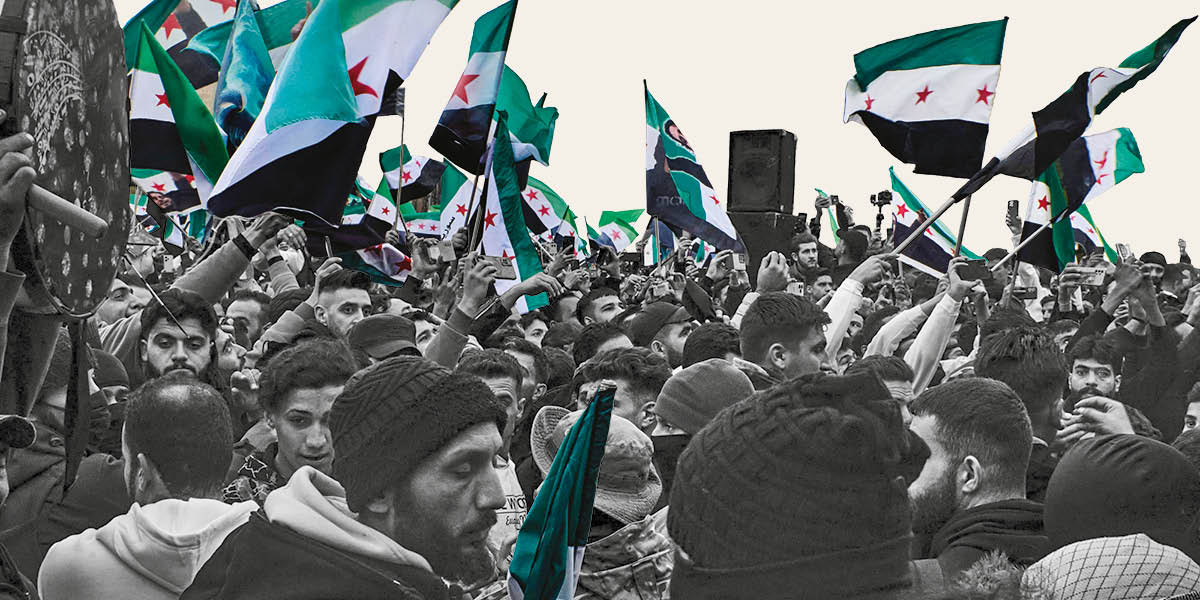In the early hours of Sunday 8 December, I watched as the brutal Assadist era, which endured for five decades in Syria, came to an end. Across the nation, city by city and town by town, statues of Hafez and Bashar al-Assad were torn down by ordinary Syrians. Could it truly be happening? Are we finally witnessing the conclusion of half a century of brutality, fear and the monopolisation of public life by a father and son? This sense of disbelief was shared by every Syrian I know.
Since the launch of the ‘Deterrence of Aggression’ military operation led by the Islamist armed group Hayat Tahrir al-Sham (HTS) – a group formerly aligned with al-Qaeda – on 27 November, Syrians have been unable to sleep. On the eleventh day after the launch of the operation, phones rang endlessly as friends and relatives sought to confirm the astonishing news spreading across social media and television: ‘Bashar al-Assad has fled to Russia.’
I remained sceptical until a friend in Damascus decided to see for herself. About three hours after the announcement, she ventured to the presidential palace in the capital. ‘No one is here,’ she reported, her voice trembling. ‘There’s no sign of the armed guards. Crowds are gathering inside the palace to see if this is truly happening. I can’t believe I’m here!’
A few minutes later, my father, a 78-year-old professor who had refused to leave our hometown Homs despite relentless harassment from Assad’s ruthless intelligence apparatus, broke his silence. ‘I never thought I would see this day,’ he said over the phone as he fought back tears. ‘I thought I would die before witnessing the end of the Assad regime.’
Joy and anxiety
In the days that followed, Syrians inside and outside the country gathered in unprecedented numbers to celebrate this historic event – the most significant political moment of our lifetimes. For the first time in over 50 years, Syrians reclaimed their squares, streets and public spaces. After enduring 14 years of chemical attacks, forced displacement, barrel bombs, systematic torture and enforced disappearances, we deserved a moment of unbridled joy. Yet beneath this overwhelming happiness, a growing sense of anxiety took hold. An internationally proscribed Islamist group with a history of human rights violations, particularly towards women, civil society and political activists, now occupies the presidential palace. What happens now?
During the military operations, the HTS leadership consistently issued statements aimed at reassuring the Syrian people, particularly religious, sectarian and ethnic minorities. The underlying message of these statements was clear: ‘We mean you no harm’. While some may find temporary reassurance in these statements, many Syrians remain deeply concerned about the lack of a clearly defined and inclusive political process to transform these assurances into tangible political, legal or constitutional measures.
There is a persistent fear that the current de facto freedom of expression is a temporary consequence of the new administration’s current inability to suppress dissent
Calls for adherence to the governance and constitutional framework outlined in United Nations security council resolution 2254, the sole internationally recognised roadmap for Syria’s transitional period and a UN facilitated national dialogue, were swiftly dismissed by the new administration. Instead, HTS rapidly established its so- called ‘salvation government’ as a ‘caretaker’ administration to ensure ‘security, stability, and the continuity of state institutions’. This was not accompanied by a clear timeline or constitutional mandate. The only promise offered was that this interim government would operate for a minimum of three months, with the eventual aim of forming a more inclusive transitional administration.
In an interview with Al Arabiya, a Saudi television channel, on 29 December 2024, HTS leader Ahmad al-Sharaa – commonly known among Syrians by his nom de guerre, Abu Mohammad al-Julani – defended the decision, describing it as ‘necessary’ to ensure the compliance and ‘coherence’ of the new administration. Al-Julani further claimed that all ministers in the salvation government possess the technical expertise and institutional competence required to maintain state services.
Scrutiny has already been directed at figures within this administration. Shadi al-Waisi, HTS’s minister of justice, is a case in point. Al-Waisi is accused of overseeing the brutal execution of two women accused of adultery in 2015, during a period when HTS operated as the Syrian branch of al-Qaeda under the name Jabhat al-Nusra. On the ground, al Sharaa’s growing base of supporters has adopted the slogan, ‘Man yuharrir yokarrir’ which translates to ‘Whoever liberates decides’ or ‘Only those who liberate make decisions’. This underscores a central theme of HTS’s political discourse: its ambition to consolidate hegemony over Syria’s polity.
Questions unanswered
The lack of transparency and clarity surrounding HTS’s medium-term transitional arrangements, coupled with its status as a proscribed organisation and the unprecedented destruction and economic collapse in Syria, which demands massive international support, has prompted a more pragmatic approach from al Sharaa. In a bid to reassure the west and advocate for the delisting of HTS as a proscribed entity, while also pushing for the lifting of economic sanctions to entice oil-rich Arab nations with the investment opportunities presented by Syria’s reconstruction, al-Sharaa unveiled plans for a ‘national dialogue’. This dialogue, he claimed, would involve representatives from all segments of Syrian society. However, no substantive details regarding its structure, timeline or mandate have been provided, leaving many critical questions unanswered.
In practice, HTS-affiliated political representatives in key provinces have approached religious, tribal and community leaders to nominate individuals for potential participation. According to several colleagues who were contacted directly or indirectly by these affiliates, the selection process appears to be heavily influenced by sectarian and ethnic identities. Such selection criteria, based on religious and sectarian lines, have exacerbated already volatile divisions in a country scarred by sectarian-based violence during the 14 years of civil war. This has led to repeated incidents of revenge attacks in what Syrians refer to as ‘mixed areas’, such as the cities of Latakia and Homs, regions with significant populations of Sunni Muslims, Alawites and Christians. These incidents highlight Syria’s most pressing transitional challenge: the fragile state of social cohesion and inter-communal tolerance among the country’s diverse religious, sectarian and ethnic groups.
Civilian peacebuilders
Civic initiatives launched by community leaders and civil society activists aimed at strengthening social cohesion and fostering community-based peacebuilding have been gaining momentum across Syria. In the immediate aftermath of Assad’s fall, young activists from diverse backgrounds mobilised to document and report incidents of sectarian driven violence. Recognising the deep divisions caused by 14 years of conflict, these activists have organised public dialogues in ‘sensitive neighbourhoods’, i.e. areas with Christian or Alawite majorities, to address fears, articulate concerns and voice social and political demands.
These grassroots, civilian-led peacebuilding efforts are already reclaiming their previously hijacked voices. For instance, community leaders and notables from five predominantly Alawite neighbourhoods in Homs issued a joint statement affirming their support for a free and democratic Syria. They emphasised the importance of equal rights for all citizens and identified social cohesion and peace as the bedrock of the country’s future. In response, leaders from Sunni-majority neighbourhoods in the city released a similar statement, highlighting the unity of the Syrian people and denouncing all forms of sectarian driven violence.
Such initiatives are not confined to Homs. Across the country, civil society groups are stepping up to facilitate communal dialogues, encourage reconciliation and lay the groundwork for a more inclusive Syria. Each day brings new announcements of community driven peacebuilding projects, focusing not only on reducing tensions but also on establishing transitional justice mechanisms and envisioning a democratic future for the nation.
In this challenging and uncertain transition, many questions remain unanswered. Civil society actors, determined to seize the historic moment, are tirelessly working to occupy public spaces and assert their visibility. Yet, their efforts are overshadowed by a persistent fear: that the current de facto freedom of expression is not a long-term reality but rather a temporary consequence of HTS’s current inability to suppress dissent. This anxiety is compounded by the looming possibility of the re-emergence of an authoritarian regime, one that could silence the nascent and gradual progress made thus far.
The preservation and expansion of these community driven civic spaces will be pivotal in shaping Syria’s future. These spaces, which provide platforms for dialogue, advocacy, and grassroots mobilisation, have the potential to foster a countervailing social power capable of challenging authoritarian tendencies. If supported and allowed to flourish, they could serve as a vital mechanism to prevent Syria from descending further into chaos, violent sectarianism and authoritarianism.
For civil society actors, this is not merely a fight for physical spaces but for the principles of freedom, inclusion and democracy. The political and identity-based polarisation is high, and the ability to sustain these civic initiatives will play a decisive role in determining whether Syria’s future is one of pluralism and hope or a return to repression and despair.










